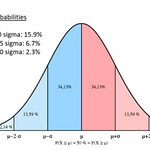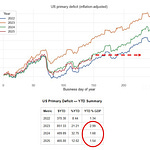Money creation is king.
It leads economic activity and therefore financial markets performance.
That’s why despite following countless macro data, market practitioners often pay particular attention to indicators tracking ‘’money printing’’.
But money isn’t a trivial topic: how do we correctly measure money creation for the real economy?
Which countries are printing more or less money today?
What does this imply for growth and markets ahead?
This article answers all these questions by:
Walking you through the principles behind the construction of my flagship Global Credit Impulse index;
Providing you with the most recent money creation figures both at a country level (US, China, EU, UK) and at an aggregate level;
Discussing the implications for economic growth and asset classes performance.
Let’s start with a 3-months old chart that speaks very loud about the importance of ‘’money printing’’:
The TMC Global Credit Impulse index (orange, left-hand side) accurately predicted the direction of travel for S&P500 earnings per share growth (blue, RHS) with a few quarters of lead time.
Back in late summer 2022, analysts were expecting EPS to grow healthily in 2023.
Our flagship money creation indicator instead suggested 2023 EPS would contract and perhaps turn negative already by March.
Well, it turns out our flagship indicator was right.
But how do we actually measure real-economy money creation?
First, let’s set the record straight: commercial banks and governments print money we can use, not Central Banks – they print money for banks, also known as bank reserves.
Here is how banks and governments print real-economy money:
When the banking system extends a loan or a mortgage, it creates a new liability for the consumer (loan/mortgage) but also a new asset (a new bank deposit).
That newly created credit is money that didn’t exist before, and it is used to purchase a new car/house.
Bank credit creation = real-economy money printing.
When the government spends more money than it taxes us for (deficit), it blows a hole in its balance sheet and throws net wealth at the private sector.
Lower taxes or stimulus cheques increase the real-economy money available for the private sector.
Government deficit spending = real-economy money printing.
Take a look back at the first chart: the more real-economy money sloshing around the largest economies in the world, the more economic growth ahead and vice versa. It makes sense, right?
We have established that bank credit creation and government deficits are key pieces of the puzzle to track real-economy money creation.
But what else is needed to build a proper money printing indicator?
How has the TMC Global Credit Impulse index changed with the latest data update?
And what does it mean for growth and markets ahead?
Let’s dig in…
Enjoyed it so far and eager to read the remaining part of this macro report?
Come join The Macro Compass premium platform to get access to Alf’s full-length timely pieces, actionable investment strategy and much more!
Check out which subscription tier suits you the most using the link below.
For more information, here is the website.












